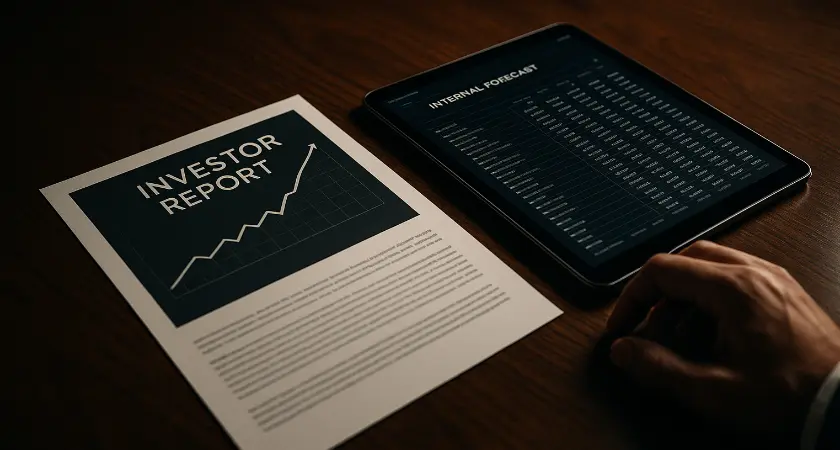Whether you're navigating the complexities of a newly public small-cap or steering a more established mid-sized enterprise, the fundamental challenge remains: how do you ensure the market truly grasps your company's value? Having sat on both sides of the table—as an institutional investor for 20 years and as SVP of Finance and IR at a public software company—I've seen that the core strategic principles of effective investor relations are remarkably universal.
In This Blog: The 6 Universal IR Truths
1. Clear Investor Narratives - Focus on value creation, not company descriptions
2. Strategic Earnings Communications - Prepare for unscripted Q&A moments
3. Consistent Trust-Building - Transparency beats spin every time
4. Quality Investor Engagement - Targeted meetings outperform broad outreach
5. Internal-External Alignment - Authentic messaging rooted in operational reality
6. Strategic Volatility Navigation - Maintain long-term focus during uncertainty
Read on for detailed strategies from a 20-year institutional investor and former public company SVP.
While companies searching for "small cap investor relations firms" may face certain unique operational hurdles, many of the most critical IR challenges transcend market cap boundaries. The difference between a company that commands its valuation and one that languishes undervalued often comes down to mastering these fundamental strategic truths, regardless of whether you're managing a $100 million or $100 billion enterprise.
The reality is this: sophisticated investors evaluate companies through consistent lenses. They seek clarity, credibility, and compelling growth narratives whether they're analyzing a nimble small-cap tech company or an established industry leader. Understanding these universal principles—and applying them with the strategic insight that only comes from deep investor experience—is what separates companies that merely exist in public markets from those that truly thrive.
Read on to uncover the strategic IR truths that can transform your investor communications, no matter your company's size.
Universal Truth 1: Crafting a Clear & Compelling Investor Narrative
Every public company, regardless of size, must articulate a persuasive investment case that transcends mere financial metrics. Your company might be revolutionary, but if your investor narrative is a tangled web of jargon and KPIs without a clear "why it matters to me as an investor," you're leaving significant value on the table.
From my seat as an institutional investor, what truly mattered in any company's narrative—regardless of market cap—was a crystal-clear explanation of how they create sustainable value and a believable path to future growth. Generic claims about "market leadership" or "innovative solutions" didn't cut it. What moved the needle were specific, credible explanations of competitive advantages, addressable market opportunities, and execution capabilities that I could evaluate and believe.
Common narrative pitfalls I observed across all company sizes:
- Explaining what the company does instead of why it matters to investors
- Focusing on product features rather than financial/investor benefits
- Adding technical complexity when simplicity was needed
- Presenting inconsistent messaging that confused the core value proposition
Having managed this challenge internally, I learned that achieving C-suite alignment on this core narrative was often the first, and hardest, step before you could effectively communicate it externally. The best narratives emerge from rigorous internal debate about your true competitive differentiation, realistic market opportunity, and honest assessment of execution risks.
The investor-centric approach requires understanding what information sophisticated investors really need. They don't want your company's story; they want to understand your investment case. The distinction is crucial and often missed by management teams who confuse corporate communications with strategic investor relations.

Universal Truth 2: Mastering Earnings Calls & Financial Communications
The quarterly earnings cycle represents a critical, high-stakes touchpoint where management credibility is tested and investor confidence is either built or eroded. An earnings call isn't just a financial report; it's a quarterly test of your leadership's strategic clarity and communication effectiveness.
As an investor, earnings calls were where the rubber met the road. It wasn't just about the numbers—though they mattered enormously—but about management's command of the business, their transparency about challenges, and their ability to articulate a clear path forward even during difficult periods.
From my SVP Finance and IR role, preparing the CEO and broader leadership team for the intense scrutiny of analyst and investor Q&A sessions was paramount. We understood that credibility was built or broken in those unscripted moments when tough questions came fast and executives had to demonstrate real strategic thinking under pressure.
Strategic elements of effective earnings communications:
- Framing performance in context, not just reporting numbers
- Managing expectations proactively
- Guiding the investment community toward realistic outcomes
- Understanding not just what happened, but why it happened and what it means for future performance
Q&A preparedness separates sophisticated management teams from those just going through the motions. The companies that thrive anticipate challenges, prepare thoughtful responses, and use difficult questions as opportunities to reinforce their strategic narrative rather than simply defend their results.

Universal Truth 3: Building & Maintaining Investor Credibility and Trust
Credibility with Wall Street isn't built on perfectly polished presentations; it's forged through consistent execution, candid communication about challenges, and a track record of doing what you said you would do.
As an investor, the quickest way a company lost my trust was through inconsistency or attempts to "spin" disappointing news rather than address it directly. The management teams that earned long-term respect were those who remained upfront about their challenges, owned their mistakes, and clearly articulated their plans to address problems.
The danger of "spin" versus authentic communication cannot be overstated. Sophisticated investors can quickly distinguish between genuine strategic communication and attempts to mask underlying issues. Companies that try to polish their way out of operational challenges typically find themselves in a credibility hole that takes years to escape.
Key elements of building lasting investor trust:
- Transparency about both successes and setbacks
- Consistency between what you say and what you deliver
- Proactive expectation management that helps investors understand your business dynamics
Universal Truth 4: Effective Investor Engagement & Strategic Meetings
The principles of preparing for and conducting impactful investor meetings apply universally, whether you're participating in large investor conferences or hosting intimate non-deal roadshow sessions. It's not simply about showing up and presenting your standard deck; it's about strategic preparation, targeted messaging, and building relationships that create lasting investor interest.
As an investor, I could always distinguish between management teams that were truly prepared for our meetings versus those just going through the motions. The best ones had researched our firm, understood our investment criteria and likely questions, and came with clear objectives for the engagement.
An investor meeting isn't a monologue; it's a strategic conversation where the most successful companies prepare not just what they'll say, but what they want to learn and how they'll build lasting relationships with the right investors.
Quality of engagement consistently outperforms quantity of meetings. Companies that focus on targeted, well-prepared interactions with strategically aligned investors achieve better results than those that pursue broad, unfocused outreach efforts.

Universal Truth 5: Aligning Internal Strategy with External Messaging
Your investor narrative cannot be a work of fiction. The most compelling stories are those authentically rooted in your company's operational reality and strategic choices—if there's a disconnect, sophisticated investors will identify it quickly and question management's strategic coherence.
As an investor, red flags immediately went up when a company's external messaging felt disconnected from what I understood about their industry dynamics, competitive position, or historical execution patterns. It often signaled potential internal misalignment or lack of strategic clarity at the leadership level.
In my SVP Finance and IR role, a significant part of my responsibility involved ensuring that our narrative to Wall Street wasn't just aspirational but was deeply rooted in our operational plans, financial forecasts, and realistic assessment of market opportunities.
The most effective approach involves having the IR function maintain:
- Deep understanding of the business
- Meaningful involvement in strategic planning processes
Consistency between external communications and internal strategic focus

Universal Truth 6: Navigating Market Volatility with Strategic Communications
Market storms are inevitable; damaging your credibility during them is not. All public companies face broader market volatility, making strategic investor relations a crucial stabilizing force during turbulent periods rather than just a fair-weather communication tool.
When market-wide concerns dominate investor sentiment, sophisticated investors often gravitate toward quality companies and management teams they trust. Companies with clear, consistent narratives and established histories of candid communication are better positioned to weather volatility than those who only communicate reactively.
From an investor's perspective, the companies that maintained my confidence during volatile periods were those that stayed true to their strategic narrative while acknowledging market realities honestly. They didn't try to predict macro trends or fight against broader market sentiment, but they clearly communicated how their specific business model and strategic positioning would enable them to navigate challenging environments.
Strategic IR during volatility focuses on:
- Maintaining consistent, credible communication
- Reinforcing your long-term value proposition
- Being transparent about near-term challenges beyond your control
- Avoiding attempts to predict market recovery timing
The Unifying Power of Strategic, Investor-Centric IR
Ultimately, the language of investor confidence and clear strategic communication transcends market capitalization boundaries. While operational specifics may differ between companies of various sizes, the fundamental strategic principles that drive successful investor relations—compelling narratives, credible communications, authentic engagement, and consistent execution—share remarkable common ground across the public markets.
The six universal truths we've explored form the foundation of effective investor relations:
- Clear investor narratives that focus on value creation rather than company descriptions
- Strategic earnings communications that build credibility through preparation and authenticity
- Consistent trust-building through transparency and reliable execution
- Effective investor engagement that prioritizes quality relationships over broad outreach
- Internal-external alignment that ensures authentic messaging rooted in operational reality
- Strategic volatility navigation that maintains long-term focus during uncertain periods
Mastering these principles requires more than tactical execution; it demands deep understanding of how investors evaluate opportunities, make decisions, and build confidence in management teams. This investor-centric perspective, combined with practical experience managing these challenges from within a public company, creates a strategic advantage that separates companies commanding their valuations from those merely hoping for market recognition.
Frequently Asked Questions
Do these IR principles really apply to companies under $500M market cap?
Yes. Sophisticated investors use consistent evaluation criteria regardless of company size.
How long does it take to see results from strategic IR?
Initial credibility improvements: 2-3 quarters. Full valuation recognition: 12-18 months.
What's the biggest IR mistake small-cap companies make?
Focusing on what their company does instead of why it matters to investors.
For leaders seeking to unlock their company's true market potential, the path forward involves embracing these universal strategic principles while working with advisors who understand both sides of the investor-company relationship. The combination of investor insight and operational experience creates the foundation for building lasting credibility and achieving the market recognition that drives sustainable shareholder value.
Explore more insights from Resurge IR on how to elevate your strategic investor relations.








